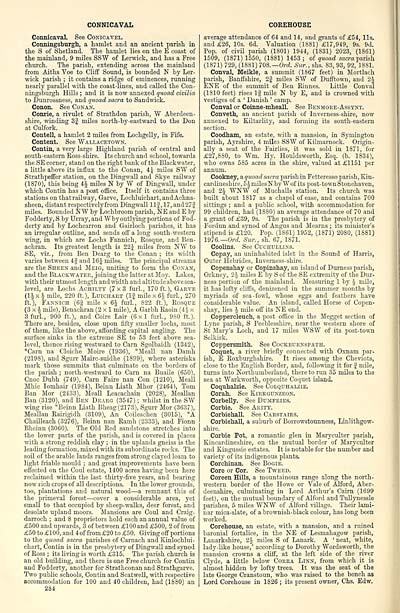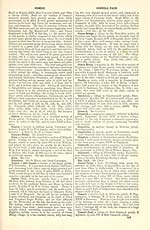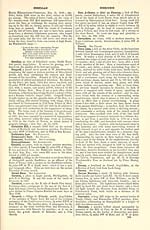Ordnance gazetteer of Scotland > Volume 1
(324) Page 284 - CON
Download files
Complete book:
Individual page:
Thumbnail gallery: Grid view | List view

CONNICAVAL
COREHOUSE
Connicaval. See Conicavel.
Conningsburgh, a hamlet and an ancient parish in
the S of Shetland. The hamlet lies on the E coast of
the mainland, 9 miles SSW of Lerwick, and has a Free
chnrch. The parish, extending across the mainland
from Aiths Voe to Cliff Sound, is bounded N by Ler-
wick parish ; it contains a ridge of eminences, running
nearly parallel with the coast-lines, and called the Con-
ningsburgh Hills ; and it is now annexed quoad civilia
to Dunrossness, and quoad sacra to Sandwick.
Conon. See Conan.
Conrie, a rivulet of Strathdon parish, W Aberdeen-
shire, winding 3| miles north-by-eastward to the Don
at Culfork.
Contell, a hamlet 2 miles from Lochgelly, in Fife.
Content. See Wallacetown.
Contin, a very large Highland parish of central and
south-eastern Ross-shire. Its church and school, towards
the SE corner, stand on the right bank of the Blackwater,
a little above its influx to the Conan, i\ miles SW of
Strathpeffer station, on the Dingwall and Skye railway
(1870), this being 4J miles N by W of Dingwall, under
which Contin has a post office. Itself it contains three
stations on that railway, Garve, Lochluichart, andAchna-
sheen, distant respectively from Dingwall llf , 17, and 27|
miles. Bounded NW by Loehbroom parish, NE and E by
Fodderty, S by Urray, and Wby outlying portions of Fod-
derty and by Lochcarron and Gairloch parishes, it has
an irregular outline, and sends off a long south-western
wing, in which are Lochs Fannich, Rosque, and Ben-
achran. Its greatest length is 22J miles from NW to
SE, viz., from Ben Dearg to the Conan ; its width
varies between 4§ and 16J miles. The principal streams
are the Sheen and Meig, uniting to form the Conan,
and the Blackwater, joining the latter at Moy. Lakes,
with their utmost length and width and altitude above sea-
level, are Lochs Aohiltt (7x3 furl., 170 ft), Garve
(1 J x h mile, 220 ft. ), Luichart (If mile x 6-i furl. , 270
ft), Fannich (6| mile x 6£ furl., 822 ft."), Rosqtje
(3 x i mile), Benachran (2x1 mile), A Garbh Raoin (4i x
3 furl, 900 ft), and Coire Lair (6x1 furl., 980 ft).
There are, besides, close upon fifty smaller lochs, most
of them, like the above, affording capital angling. The
surface sinks in the extreme SE to 53 feet above sea-
level, thence rising westward to Carn Sgolbaidh (1342),
*Carn na Cloiche Moire (1936), *Meall nan Damh
(2198), and Sgurr Mairc-suidhe (1899), where asterisks
mark those summits that culminate on the borders of
the parish ; north-westward to Carn na Buaile (650),
Cnoe Dubh (749), Carn Faire nan Con (1210), Meall
Mhic Iomhair (19S4), Beinn Liath Mhor (2464), Tom
Ban Mor (2433), Meall Leacachain (2028), Meallan
Ban (3120), and Ben Dearg (3547) ; whilst in the SW
wing rise *Beinn Liath Bheag(2173), Sgurr Mor (3637),
Meallan Rairigidh (3109), An Coileachen (3015), *A
Chailleach (3276), Beinn nan Ramh (2333), and Fionn
Bheinn (3060). The Old Red sandstone stretches into
the lower parts of the parish, and is covered in places
with a strong reddish clay ; in the uplands gneiss is the
leading formation, mixed with its subordinate rocks. The
soil of the arable lands ranges from strong clayed loam to
light friable mould ; and great improvements have been
effected on the Coul estate, 1400 acres having been here
reclaimed within the last thirty-five years, and bearing
now rich crops of all descriptions. In the lower grounds,
too, plantations and natural wood — a remnant this of
the primeval forest — cover a considerable area, yet
small to that occupied by sheep-walks, deer forest, and
desolate upland moors. Mansions are Coul and Craig -
darroch ; and 8 proprietors hold each an annual value of
£500 and upwards, 3 of between £100and £500, 2offrom
£50 to £100, and 4 of from£20 to £50. Giving off portions
to the quoad sacra parishes of Carnach and Kinlochlui-
chart, Contin is in the presbytery of Dingwall and synod
of Ross ; its living is worth £315. The parish church is
an old building, and there is one Free church for Contin
and Fodderty, another for Strathconan and Strathgarve.
Two public schools, Contin and Scatwell, with respective
accommodation for 100 and 40 children, had (1880) an
284
average attendance of 64 and 14, and grants of £54, lis.
and £26, 10s. 6d. Valuation (1881) £17,949, 9s. 9d.
Pop. of civil parish (1801) 1944, (1831) 2023, (1861)
1509, (1871)1550, (1881) 1453; of quoad sacra parish
(1871) 729, (1881) 708.— Ord. Sur., shs. 83, 93, 92, 1881.
Conval, Weikle, a summit (1867 feet) in Mortlach
parish, Banffshire, 2J miles SW of Dufftown, and 2J
ENE of the summit of Ben Rinnes. Little Conval
(1810 feet) rises If mile N by E, and is crowned with
vestiges of a ' Danish ' camp.
Conval or Coinne-mheall. See Benmore-Assynt.
Conveth, an ancient parish of Inverness-shire, now
annexed to Kiltarlity, and forming its south-eastern
section.
Coodham, an estate, with a mansion, in Symington
parish, Ayrshire, 4 miles SSW of Kilmarnock. Origin-
ally a seat of the Fairlies, it was sold in 1871, for
£27,880, to Win. Hy. Houldsworth, Esq. (b. 1834),
who owns 585 acres in the shire, valued at £1151 per
annum.
Cookney, a quoad sacra parish in Fetteresso parish, Kin-
cardineshire, 5^ miles N by Wof its post-town Stonehaven,
and 2J WNW of Muchalls station. Its church was
built about 1S17 as a chapel of ease, and contains 700
sittings ; and a public school, with accommodation for
99 children, had (1880) an average attendance of 70 and
a grant of £39, 9s. The parish is in the presbytery of
Fordun and synod of Angus and Mearns ; its minister's
stipend is £120. Pop. (1S61) 1952, (1871) 2080, (1881)
1976.— Ord. Sur., sh. 67, 1871.
Coolins. See Cuchullins.
Copay, an uninhabited islet in the Sound of Harris,
Outer Hebrides, Inverness-shire.
Copenshay or Copinshay, an island of Durness parish,
Orkney, 2\ miles E by S of the SE extremity of the Dur-
ness portion of the mainland. Measuring 1 by \ mile,
it has lofty cliffs, denizened in the summer months by
myriads of sea -fowl, whose eggs and feathers have
considerable value. An island, called Horse of Copen-
shay, lies \ mile off its NE end.
Coppercleuch, a post office in the Megget section of
Lyne parish, S Peeblesshire, near the western shore of
St Mary's Loch, and 17 miles WSW of its post-town
Selkirk.
Coppersmith. See Cockburnspath.
Coquet, a river briefly connected with Oxnam par-
ish, E Roxburghshire. It rises among the Cheviots,
close to the English Border, and, following it for f mile,
turns into Northumberland, thereto run 35 miles to the
sea at Warkworth, opposite Coquet island.
Coquhalzie. See Colquhalzie.
Corah. See Kirkgunzeon.
Corbelly. See Dumfries.
Corbie. See Arity.
Corbiehall. See Carstairs.
Corbiehall, a suburb of Borrowstounness, Linlithgow-
shire.
Corbie Pot, a romantic glen in Maryculter parish,
Kincardineshire, on the mutual border of Maryculter
and Kingussie estates. It is notable for the number and
variety of its indigenous plants.
Corchinan. See Bogie.
Core or Cor. See Tweed.
Coreen Hills, a mountainous range along the north-
western border of the Howe or Vale of Alford, Aber-
deenshire, culminating in Lord Arthur's Cairn (1699
feet), on the mutual boundary of Alford and TuUynessle
parishes, 5 miles WNW of Alford village. Their lami-
nar mica-slate, of a brownish-black colour, has long been
worked.
Corehouse, an estate, with a mansion, and a ruined
baronial fortalice, in the NE of Lesmahagow parish,
Lanarkshire, 2i miles S of Lanark. A ' neat, white,
lady-like house,' according to Dorothy Wordsworth, the
mansion crowns a cliff, at the left side of the river
Clyde, a little below Corra Linn, from which it is
almost hidden by lofty trees. It was the seat of the
late George Cranstoun, who was raised to the bench as
Lord Corehouse in 1826 ; its present owner, Chs. Edw.
COREHOUSE
Connicaval. See Conicavel.
Conningsburgh, a hamlet and an ancient parish in
the S of Shetland. The hamlet lies on the E coast of
the mainland, 9 miles SSW of Lerwick, and has a Free
chnrch. The parish, extending across the mainland
from Aiths Voe to Cliff Sound, is bounded N by Ler-
wick parish ; it contains a ridge of eminences, running
nearly parallel with the coast-lines, and called the Con-
ningsburgh Hills ; and it is now annexed quoad civilia
to Dunrossness, and quoad sacra to Sandwick.
Conon. See Conan.
Conrie, a rivulet of Strathdon parish, W Aberdeen-
shire, winding 3| miles north-by-eastward to the Don
at Culfork.
Contell, a hamlet 2 miles from Lochgelly, in Fife.
Content. See Wallacetown.
Contin, a very large Highland parish of central and
south-eastern Ross-shire. Its church and school, towards
the SE corner, stand on the right bank of the Blackwater,
a little above its influx to the Conan, i\ miles SW of
Strathpeffer station, on the Dingwall and Skye railway
(1870), this being 4J miles N by W of Dingwall, under
which Contin has a post office. Itself it contains three
stations on that railway, Garve, Lochluichart, andAchna-
sheen, distant respectively from Dingwall llf , 17, and 27|
miles. Bounded NW by Loehbroom parish, NE and E by
Fodderty, S by Urray, and Wby outlying portions of Fod-
derty and by Lochcarron and Gairloch parishes, it has
an irregular outline, and sends off a long south-western
wing, in which are Lochs Fannich, Rosque, and Ben-
achran. Its greatest length is 22J miles from NW to
SE, viz., from Ben Dearg to the Conan ; its width
varies between 4§ and 16J miles. The principal streams
are the Sheen and Meig, uniting to form the Conan,
and the Blackwater, joining the latter at Moy. Lakes,
with their utmost length and width and altitude above sea-
level, are Lochs Aohiltt (7x3 furl., 170 ft), Garve
(1 J x h mile, 220 ft. ), Luichart (If mile x 6-i furl. , 270
ft), Fannich (6| mile x 6£ furl., 822 ft."), Rosqtje
(3 x i mile), Benachran (2x1 mile), A Garbh Raoin (4i x
3 furl, 900 ft), and Coire Lair (6x1 furl., 980 ft).
There are, besides, close upon fifty smaller lochs, most
of them, like the above, affording capital angling. The
surface sinks in the extreme SE to 53 feet above sea-
level, thence rising westward to Carn Sgolbaidh (1342),
*Carn na Cloiche Moire (1936), *Meall nan Damh
(2198), and Sgurr Mairc-suidhe (1899), where asterisks
mark those summits that culminate on the borders of
the parish ; north-westward to Carn na Buaile (650),
Cnoe Dubh (749), Carn Faire nan Con (1210), Meall
Mhic Iomhair (19S4), Beinn Liath Mhor (2464), Tom
Ban Mor (2433), Meall Leacachain (2028), Meallan
Ban (3120), and Ben Dearg (3547) ; whilst in the SW
wing rise *Beinn Liath Bheag(2173), Sgurr Mor (3637),
Meallan Rairigidh (3109), An Coileachen (3015), *A
Chailleach (3276), Beinn nan Ramh (2333), and Fionn
Bheinn (3060). The Old Red sandstone stretches into
the lower parts of the parish, and is covered in places
with a strong reddish clay ; in the uplands gneiss is the
leading formation, mixed with its subordinate rocks. The
soil of the arable lands ranges from strong clayed loam to
light friable mould ; and great improvements have been
effected on the Coul estate, 1400 acres having been here
reclaimed within the last thirty-five years, and bearing
now rich crops of all descriptions. In the lower grounds,
too, plantations and natural wood — a remnant this of
the primeval forest — cover a considerable area, yet
small to that occupied by sheep-walks, deer forest, and
desolate upland moors. Mansions are Coul and Craig -
darroch ; and 8 proprietors hold each an annual value of
£500 and upwards, 3 of between £100and £500, 2offrom
£50 to £100, and 4 of from£20 to £50. Giving off portions
to the quoad sacra parishes of Carnach and Kinlochlui-
chart, Contin is in the presbytery of Dingwall and synod
of Ross ; its living is worth £315. The parish church is
an old building, and there is one Free church for Contin
and Fodderty, another for Strathconan and Strathgarve.
Two public schools, Contin and Scatwell, with respective
accommodation for 100 and 40 children, had (1880) an
284
average attendance of 64 and 14, and grants of £54, lis.
and £26, 10s. 6d. Valuation (1881) £17,949, 9s. 9d.
Pop. of civil parish (1801) 1944, (1831) 2023, (1861)
1509, (1871)1550, (1881) 1453; of quoad sacra parish
(1871) 729, (1881) 708.— Ord. Sur., shs. 83, 93, 92, 1881.
Conval, Weikle, a summit (1867 feet) in Mortlach
parish, Banffshire, 2J miles SW of Dufftown, and 2J
ENE of the summit of Ben Rinnes. Little Conval
(1810 feet) rises If mile N by E, and is crowned with
vestiges of a ' Danish ' camp.
Conval or Coinne-mheall. See Benmore-Assynt.
Conveth, an ancient parish of Inverness-shire, now
annexed to Kiltarlity, and forming its south-eastern
section.
Coodham, an estate, with a mansion, in Symington
parish, Ayrshire, 4 miles SSW of Kilmarnock. Origin-
ally a seat of the Fairlies, it was sold in 1871, for
£27,880, to Win. Hy. Houldsworth, Esq. (b. 1834),
who owns 585 acres in the shire, valued at £1151 per
annum.
Cookney, a quoad sacra parish in Fetteresso parish, Kin-
cardineshire, 5^ miles N by Wof its post-town Stonehaven,
and 2J WNW of Muchalls station. Its church was
built about 1S17 as a chapel of ease, and contains 700
sittings ; and a public school, with accommodation for
99 children, had (1880) an average attendance of 70 and
a grant of £39, 9s. The parish is in the presbytery of
Fordun and synod of Angus and Mearns ; its minister's
stipend is £120. Pop. (1S61) 1952, (1871) 2080, (1881)
1976.— Ord. Sur., sh. 67, 1871.
Coolins. See Cuchullins.
Copay, an uninhabited islet in the Sound of Harris,
Outer Hebrides, Inverness-shire.
Copenshay or Copinshay, an island of Durness parish,
Orkney, 2\ miles E by S of the SE extremity of the Dur-
ness portion of the mainland. Measuring 1 by \ mile,
it has lofty cliffs, denizened in the summer months by
myriads of sea -fowl, whose eggs and feathers have
considerable value. An island, called Horse of Copen-
shay, lies \ mile off its NE end.
Coppercleuch, a post office in the Megget section of
Lyne parish, S Peeblesshire, near the western shore of
St Mary's Loch, and 17 miles WSW of its post-town
Selkirk.
Coppersmith. See Cockburnspath.
Coquet, a river briefly connected with Oxnam par-
ish, E Roxburghshire. It rises among the Cheviots,
close to the English Border, and, following it for f mile,
turns into Northumberland, thereto run 35 miles to the
sea at Warkworth, opposite Coquet island.
Coquhalzie. See Colquhalzie.
Corah. See Kirkgunzeon.
Corbelly. See Dumfries.
Corbie. See Arity.
Corbiehall. See Carstairs.
Corbiehall, a suburb of Borrowstounness, Linlithgow-
shire.
Corbie Pot, a romantic glen in Maryculter parish,
Kincardineshire, on the mutual border of Maryculter
and Kingussie estates. It is notable for the number and
variety of its indigenous plants.
Corchinan. See Bogie.
Core or Cor. See Tweed.
Coreen Hills, a mountainous range along the north-
western border of the Howe or Vale of Alford, Aber-
deenshire, culminating in Lord Arthur's Cairn (1699
feet), on the mutual boundary of Alford and TuUynessle
parishes, 5 miles WNW of Alford village. Their lami-
nar mica-slate, of a brownish-black colour, has long been
worked.
Corehouse, an estate, with a mansion, and a ruined
baronial fortalice, in the NE of Lesmahagow parish,
Lanarkshire, 2i miles S of Lanark. A ' neat, white,
lady-like house,' according to Dorothy Wordsworth, the
mansion crowns a cliff, at the left side of the river
Clyde, a little below Corra Linn, from which it is
almost hidden by lofty trees. It was the seat of the
late George Cranstoun, who was raised to the bench as
Lord Corehouse in 1826 ; its present owner, Chs. Edw.
Set display mode to: Large image | Transcription
Images and transcriptions on this page, including medium image downloads, may be used under the Creative Commons Attribution 4.0 International Licence unless otherwise stated. ![]()
| Gazetteers of Scotland, 1803-1901 > Ordnance gazetteer of Scotland > Volume 1 > (324) Page 284 - CON |
|---|
| Permanent URL | https://digital.nls.uk/97372654 |
|---|
| Attribution and copyright: |
|
|---|---|

